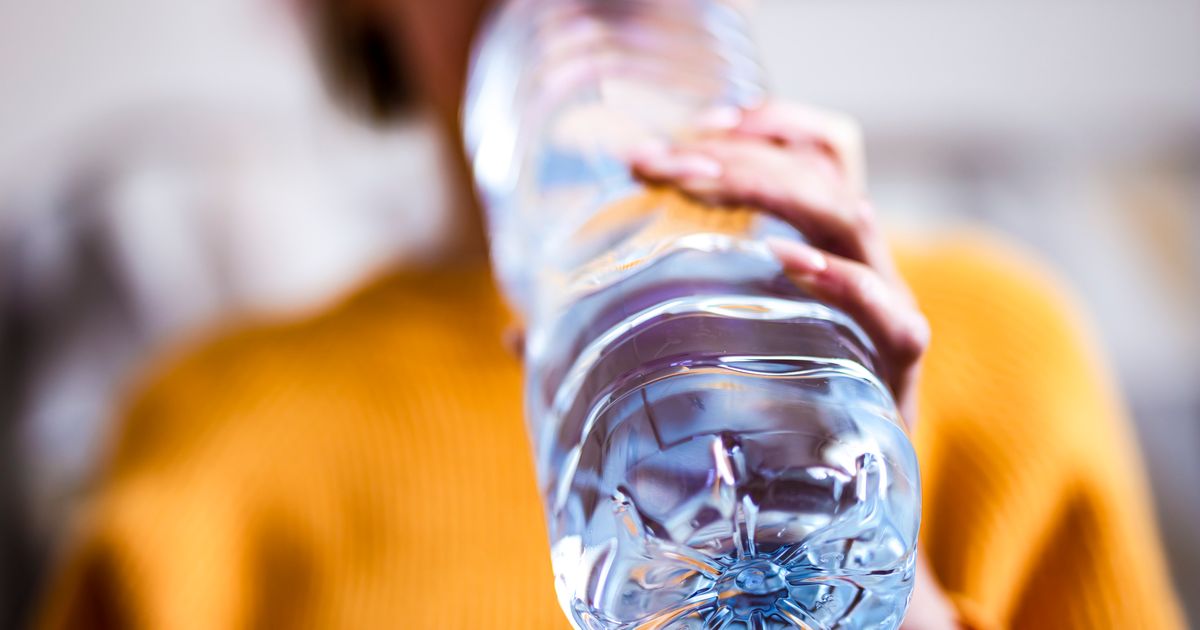As of 2017, people worldwide are purchasing plastic water bottles at the rate of 1 million bottles per minute, with the average American consuming 45 gallons of bottled water apiece every year.
And though bottled water sales have continued to skyrocket since 2010 ― climbing to a whopping 15 billion gallons of bottled water sold in the United States in 2020 ― data shows and experts say there are compelling reasons to ditch the plastic for good.
There’s some evidence that shows bottled water may contain potentially harmful chemicals in its packaging.
Phthalates, also called plasticizers, are a class of manmade chemicals used to make water bottles and other plastics more durable and flexible. Phthalate exposure has been warned against because of how the chemicals affect a person’s endocrine system, which is the system that produces and releases hormones.
Some studies have found that plastic water bottles alone don’t have contamination levels significant enough to cause harm to bottled water drinkers. However, multiple experts told HuffPost that because most people are already exposed to endocrine-disrupting chemicals from many other sources every day ― from housecleaning products to some fragrances ― it may be wise to limit additional exposure to such chemicals where possible.
The U.S. Environmental Protection Agency (EPA) is concerned enough about these potential effects that it moved last month to designate another common endocrine-disrupting chemical class, known as PFAS, as “hazardous substances.” These are colloquially called “forever chemicals,” because they can stick around in the environment for decades.
Though phthalates and other endocrine-disrupting chemicals aren’t usually detected in water at its original source, the plastic surrounding bottled water can contaminate the liquid over time. Degrees of contamination vary, but experts say that plastic-to-liquid contamination is mostly exacerbated by two things: the amount of time the plastic and drink (or food) are in direct contact, and whether the plastic has been heated while touching the food or liquid.
Bottled water is concerning on both fronts because it’s often stored in warehouses for extended periods of time and then on modes of transportation where temperatures can be high.
“Sitting in such conditions for months or even years before making its way to the consumer is a very long time for such a small amount of water to be surrounded by so much hot plastic,” Dr. Nathaniel DeNicola, an OB-GYN and environmental health expert for the American College of Obstetricians & Gynecologists, told HuffPost.
Emily Barrett, an associate professor of biostatistics and epidemiology at Rutgers School of Public Health, added that the reason phthalates separate from plastics in the first place is because they are not part of the plastic matrix itself but are loosely bound to it.
“When exposed to heat, the chemical bonds can break relatively easily, allowing the phthalates to leach into the food or drink contained in that plastic packaging,” she said, noting that such contamination can also occur during production stages when bottled water comes in contact with PVC — one of the world’s most widely produced plastics, known for its hardness — and other plastic machinery.
“Water bottles can be susceptible to contamination because of the prolonged direct contact between the water and the plastic packaging materials.”
– Dr. Maida Galvez, professor of environmental medicine and public health at Icahn School of Medicine
The amount of plastic surrounding such a relatively small amount of water is also worth consideration.
“Water bottles can be susceptible to contamination because of the prolonged direct contact between the water and the plastic packaging materials and large surface area of contact,” said Dr. Maida Galvez, professor of environmental medicine and public health at Icahn School of Medicine, Mount Sinai in New York City.
Metals, bacteria, plastic pieces and more have been found in bottled water before.
Beyond possible exposure to such chemicals, multiple studies have found other substances in bottled water.
“Studies have found traces of pharmaceuticals, microplastics, bacteria and heavy metals,” Barrett explained. Indeed, a Journal of Environmental Health study found heavy metals such as silver, barium, cobalt, chromium, copper, nickel, lead and zinc in several popular bottled water brands.
What’s more, research published in 2019 by the National Library of Medicine also found toxins, bacteria, fungus and “microbiological pollutants” in bottled water that are responsible for different diseases in humans, most frequently gastroenteritis or stomach flu.
The study concluded that bottled water is often considered to be safe and sterile, “but, the risk for health should not be minimized [when] taking into account the microbial metabolic diversity and versatility making different species capable to survive, and even multiply in the conditions offered by bottled waters.”
The Centers for Disease Control and Prevention has warned that “contaminated bottled water can harm your health, including causing gastrointestinal illness, reproductive problems, and neurological disorders.” It states that people with weakened immune systems “may be more likely to get sick from some contaminants” and advises what immunocompromised people can look out for on bottled water labels to protect against the microscopic parasite Cryptosporidium, also known as Crypto. The parasite is harmless to most consumers (one study showed that about 80% of North American adults have ingested the parasite before, but most didn’t know they had it) but could cause immunocompromised persons to have “chronic or severe illness and even life-threatening symptoms.”
mikroman6 via Getty Images
Beyond bacteria concerns, testing by Consumer Reports in 2020 found worrisome levels of arsenic in some bottled water as well. A very small 2018 Frontiers in Chemistry study also found microplastics ― tiny fragments of plastic ― in 93% of the 259 bottled water samples that were analyzed. Some such fragments were large enough to be visible without a magnifying glass or microscope.
And though microplastic particles have been found in many other places (a 2019 study found that microplastics were in the air surrounding a mountain range in France), Sherri Mason, author of the Frontiers in Chemistry study and a sustainability researcher at Penn State Behrend, told Time magazine in 2019 that such chemicals are especially abundant in bottled water. In addition to being found in the plastic bottle itself, she explained, the act of bottling the water can also cause “fragments of polypropylene” (used to make bottled water caps) to enter the contents of the bottle. She noted that microplastics have been found in tap water as well, but are found “about twice as much” in bottled water.
Bottled water may be deficient in essential natural minerals more commonly found in tap water.
In 2001, McGill University researchers looked at levels of essential minerals such as calcium, magnesium, and sodium commonly found in tap water and compared the result to levels found in many brands of bottled water. The team discovered that tap water contained significantly higher levels of such minerals than U.S. spring water bottled water brands.
Its findings also showed that drinking just two liters of tap water in some cities can alone fulfill between 6% and 18% of one’s recommended daily allowance of calcium — a point DeNicola said is of particular importance.
“Too many people are getting their vitamin D and calcium from supplemental sources like multivitamins these days,” he said. He said that some research suggests that, in some cases, too much calcium through supplements could even take a toll on your heart, so it’s a good idea to try to obtain vitamins and minerals from natural dietary sources as much as possible and to supplement as a secondary measure.
And, of course, plastic bottles are awful for the environment.
Though this one is a no-brainer and has already been covered extensively before, it’s worth mentioning. For starters, the life cycle of each bottle of water comes with a hefty carbon footprint that contributes to climate change. It also causes tremendous pollution as an estimated amount of only 8.7% of water bottles end up being recycled.
What’s more, the manufacturing of bottled water has a massive water footprint as well. According to NPR, the amount of water going into packaging, transportation and production of each bottle could end up being six to seven times the amount of water that’s inside each bottle.
So, what can we do about this?
How much ― if any ― significant harm comes from bottled water varies from person to person, the experts said. It’s difficult to measure. Instead, they just want consumers to be informed when making a decision.
Multiple studies also show that people aren’t drinking enough water to begin with, and the experts stressed that people need to be drinking much more water each day.
“The first advice I have is to drink water!” Galvez said. “Safe and healthy drinking water is vital to life.”
If you are looking to reduce your plastic bottled water intake, here’s what to consider:
Drink tap water if you’re able.
Sounds like an obvious answer, but many people don’t for a variety of reasons. For some in certain areas of the country, it’s been actively dangerous to do so.
Many people buy bottled water because they believe it’s sourced from mountain streams or filtered in a uniquely powerful or thorough manner. But experts say that mountain water sources are rare and may not be any “purer” than most municipal water sources, and that many popular bottled water brands source their water directly from tap water.
And though the 1974 Safe Drinking Water Act legally gave regulatory oversight of public drinking water in the United States to the EPA, the Food and Drug Administration assumed responsibility soon thereafter. Today, the FDA is responsible for ensuring that quality standards for bottled water are compatible with EPA standards for public drinking water, but the agency acknowledges on its website that, “in some cases, standards for bottled water and public drinking water differ,” and that when the “EPA establishes a standard for a contaminant, the FDA either adopts it for bottled water or finds that the standard isn’t necessary for bottled water.”
“Tap water is tested dozens to hundreds of times a day and those tests are required to be publicly available,” Mason told HuffPost. “This is not the case with bottled water, so you don’t know what’s really in it.”
Get a filter for sink water.
It’s also worth noting that the water filtration system used in many bottled water brands is likely no different than the kind of filtration systems one can purchase for home use or what comes included with many brands of refrigerators.
“Our family installed a reverse osmosis filter in our kitchen sink,” Barrett said. She added: “Despite marketing claims, in many cases the bottled water you buy is no ‘purer’ than water coming out of your tap.”
Look for alternative bottles.
“No one brand of plastic water bottles are safer than another,” Mason advised. “If you have to purchase bottled water, purchase it bottled in glass if it’s an option.”
If the concern is mostly-convenience related, consider investing in a quality reusable bottle. “Choose reusable water bottles that are stainless steel,” Galvez said. “They are better for you and for the environment.”
Store any plastic bottled water correctly.
Barrett counseled that if one still wants to drink water bottled in plastic, to “keep it in a cool place,” and to “drink it relatively quickly without storing it for years,” to avoid further phthalate contamination.
“Sometimes bottled water is unavoidable and that’s OK,” she said. “But it should be a back-up, not your first choice.”


